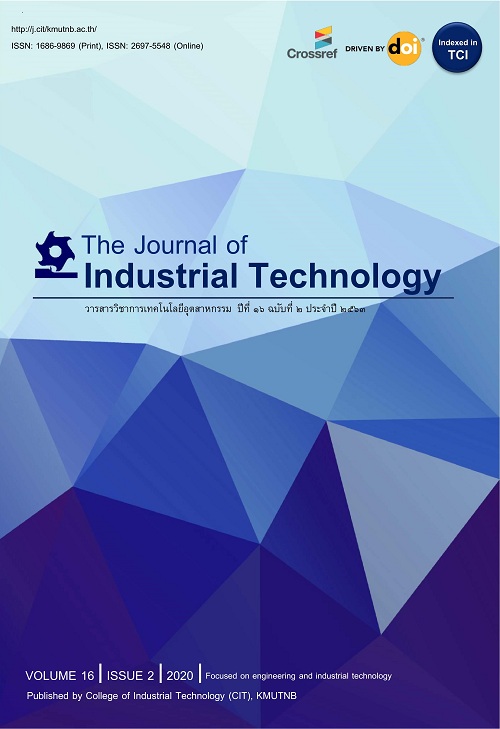Physical Properties, Compressive Strength and Microstructure of Interlocking Concrete Paving Block Containing Bamboo Ash
สมบัติทางกายภาพ กำลังอัด และโครงสร้างระดับจุลภาคของคอนกรีตบล็อกประสานปูพื้นผสมเถ้าไม้ไผ่
Abstract
งานวิจัยนี้มุ่งศึกษาสมบัติทางกายภาพ สมบัติทางกล และโครงสร้างระดับจุลภาคของคอนกรีตบล็อกประสานปูพื้นที่ใช้เถ้าไม้ไผ่แทนที่ปูนซีเมนต์บางส่วน ในอัตราส่วนร้อยละ 10, 20 และ 30 โดยน้ำหนัก ทำการทดสอบขนาดมิติรูปร่าง ความหนาแน่น การดูดซึมน้ำ และโครงสร้างระดับจุลภาค ประกอบด้วย ภาพถ่ายกำลังขยายสูงโดยเทคนิคกล้องจุลทรรศน์อิเล็คตรอนแบบส่องกราด การวิเคราะห์ธาตุด้วยสเปกโทรเมตรีรังสีเอกซ์แบบกระจายพลังงาน และสารประกอบโดยเทคนิควิเคราะห์การเลี้ยวเบนของรังสีเอ็กซ์ นอกจากนั้น ยังมีการทดสอบเปรียบเทียบคอนกรีตบล็อกประสานปูพื้นที่ใช้วิธีการบ่มน้ำและบ่มอากาศ จากผลการทดสอบ พบว่า การทดสอบขนาดมิติรูปร่างเป็นไปตามมาตรฐาน ASTMC936/C936M ความหนาแน่นของคอนกรีตบล็อกประสานปูพื้นอยู่ในช่วง 2,111-2,209 กิโลกรัมต่อลูกบาศก์เมตร การดูดซึมน้ำมีแนวโน้มเพิ่มขึ้นอย่างมีนัยสำคัญเมื่อมีปริมาณเถ้าไม้ไผ่เพิ่มขึ้น การผสมเถ้าไม้ไผ่ร้อยละ 10 โดยน้ำหนัก ทำให้ค่ากำลังอัดได้ดีที่สุดเมื่อบ่มน้ำที่อายุ 60 วัน และโครงสร้างระดับจุลภาคพบแคลเซียมซิลิเกตไฮเดรตและแอททริงไกต์ ดังนั้น เถ้าไม้ไผ่สามารถนำแทนที่ซีเมนต์ผสมสำหรับงานเฉพาะบางชนิดได้
This research focused on studying the physical properties, mechanical properties, and microstructure of concrete interlocking blocks that use bamboo ash as a partial replacement of cement. In the 10, 20, and 30 percentages by weight of cement, dimensions of shape, density, water absorption, and microstructure were tested. High-magnification imaged by scanning electron microscope technique elemental analysis with energy-dispersed X-ray spectrometry and compounds by X-ray diffraction analysis technique. In addition to that, there was a comparative test of concrete blocks interlocking paving using water curing and air curing methods. According to the test results, the dimensional dimension test was following ASTM C936/C936M standards, the density of concrete interlocking blocks for paving is in the range of 2,111-2,209 kilograms per cubic meter. Water absorption tended to increase significantly with an increase in bamboo ash content. Mixing 10% bamboo ash by weight provided the best compressive strength, curing water at 60 days of age, and the microstructure found calcium silicate hydrate and ettringite. Therefore, bamboo ash can replace cement mixtures for some specific applications.
Keywords
[1] B. Warinlai and P. Krammart, Slump, compressive strength, chloride penetration resistance and carbonation of concrete with partial replacement of cement by fly ash, ground bottom ash, limestone powder, The Journal of KMUTNB, 2021, 31(3), 438-449. (in Thai)
[2] C.H. Huang, S.K. Lin, C.S. Chang and H.J. Chen, Mix proportions and mechanical properties of concrete containing very high-volume of class F fly ash, Construction and Building Materials, 2013, 46, 71-78.
[3] M. da S. Magalhães, B.F. Cezar and P.R. Lustosa, Influence of Brazilian fly ash fineness on the cementing efficiency factor, compressive strength and Young's modulus of concrete, Developments in the Built Environment, 2023, 14, 100147.
[4] W. Chalee, T. Cheewaket and C. Jaturapitakkul, Enhanced durability of concrete with palm oil fuel ash in a marine environment, Journal of Materials Research and Technology, 2021, 13, 128-137.
[5] A.M. Zeyad, M.A.M. Johari, A. Abadel, A. Abutaleb, M.J.A. Mijarsah and A. Almalki, Transport properties of palm oil fuel ash-based high-performance green concrete subjected to steam curing regimes, Case Studies in Construction Materials, 2022, 16, e01077.
[6] C. Hansudewechakul, W. Uttavachon, V. Nuntarplom, A. Noalseesai and M. Srivichai, Mechanical properties study of concrete block containing bagasse ash and corn cob ash, Wichcha Journal Nakhon Si Thammarat Rajabhat University, 2018, 37(1), 69-80. (in Thai)
[7] T. Klathae,N. Sornpakdee,C. Buathongkhueand N. Deedard,Utilization of parawood ash in concrete paving blocks,Rajamangala University of Technology Srivijaya Research Journal,2020, 12(1), 36-48. (in Thai)
[8] TIS 827-2565, Standard Specification for Interlocking Concrete Paving Blocks, 2022. (in Thai)
[9] A.R. Djamaluddin, M.A. Caronge, M.W. Tjaronge, A.T. Lando and R. Irmawaty, Evaluation of sustainable concrete paving blocks incorporating processed waste tea, Case Studies in Construction Materials, 2020, 12, e00325.
[10] S.O. Odeyemi, O.D. Atoyebi, O.S. Kegbeyale, M.A. Anifowose, O.T. Odeyemi, A.G. Adeniyi and O.A. Orisadare, Mechanical properties and microstructure of high-performance concrete with bamboo leaf ash as additive, Cleaner Engineering and Technology, 2022, 6, 100352.
[11] A.A. Umoh and I. Odesola, Characteristics of bamboo leaf ash blended cement paste and mortar, Civil Engineering Dimension, 2015, 17(1), 22-28.
[12] L.H.P. Silva, J.R. Tamashiro, F.F.G. de Paiva, L.F. dos Santos, S.R. Teixeira, A. Kinoshita, and P.A. Antunes, Bamboo leaf ash for use as mineral addition with Portland cement, Journal of Building Materials, 2021, 42, 102769.
[13] G. Abebaw, B. Bewket and S. Getahun, Experimental investigation on effect of partial replacement of cement with bamboo leaf ash on concrete property, Advances in Civil Engineering, 2021, 6468444.
[14] ASTM C150-2007, Standard Specification for Portland Cement, 2007.
[15] ASTM C618-2019, Standard Specification for Coal Fly Ash and Raw or Calcined Natural Pozzolan for Use in Concrete, 2019.
[16] ASTM C936/C936M-21, Standard Specification for Solid Concrete Interlocking Paving Units1, 2021.
[17] S. Kolias and C. Georgiou, The effect of paste volume and of water content on the strength and water absorption of concrete, Cement and Concrete Composites, 2005, 27(2), 211- 216.
[18] X. Wang, M. Sun and S. Guo, Water absorption characteristics of cement-based materials based on the chemical reaction, Construction and Building Materials, 2019, 220, 607-614.
[19] E. Aprianti, P. Shafigh, S. Bahri and J.N. Farahani, Supplementary cementitious materials origin from agricultural wastes – A review, Construction and Building Materials, 2015, 74, 176-187.
[20] S.W.M. Supit, F.U.A. Shaikh and P.K. Sarker, Effect of ultrafine fly ash on mechanical properties of high-volume fly ash mortar, Construction and Building Materials, 2014, 51, 278-286.
[21] S. Lubej, I. Anžel, P. Jelušič, L. Kosec and A. Ivanič, The effect of delayed ettringite formation on fine grained aerated concrete mechanical properties, Science and Engineering of Composite Materials, 2016, 23(3), 325-334.
[22] E.D. Perez-Diaz, J.L. Reyes-Araiza, B.M. Millán-Malo, S.M. Londoño-Restrepo and M.E. Rodríguez-Garcia, Evaluation of bamboo cortex ash as supplementary cementitious material: Comparative analysis with sugarcane bagasse ash and natural pozzolan, Journal of Building Engineering, 2023, 66, 105846.
DOI: 10.14416/j.ind.tech.2024.04.004
Refbacks
- There are currently no refbacks.






